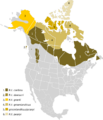Dolphin-Union caribou facts for kids
Quick facts for kids Dolphin and Union Caribou herd |
|
|---|---|
| Conservation status | |
 Special Concern (COSEWIC) |
|
| Scientific classification | |
| Kingdom: | |
| Phylum: | |
| Class: | |
| Order: | |
| Family: | |
| Genus: | |
| Species: | |
| Subspecies: | |
| Trinomial name | |
| Rangifer tarandus groenlandicus COSEWIC 2004
|
|
 |
|
| Approximate range of caribou. Dolphin and Union population occupy area 5 and parts of area 4. Overlap with other subspecies of caribou is possible for contiguous range. 1. Rangifer tarandus caribou subdivided into ecotypes: woodland (boreal), woodland (migratory), woodland (montane), 2.R. t. Dawsoni extinct 1907, 3. R. t. granti, 4. Barren-ground caribou R. t. groenlandicus, 5. Groenlandicus/Pearyi 6. Peary caribou R. t. pearyi | |
The Dolphin and Union Caribou are a special group of barren-ground caribou. People sometimes call them Island Caribou. They live on Victoria Island in the Canadian Arctic Archipelago and the nearby mainland. These caribou are found only in Canada.
What makes them unique is their migration. They travel across the Dolphin and Union Strait. In summer, they graze on Victoria Island. For winter, they cross the sea ice to the Nunavut-Northwest Territories mainland. It is very unusual for caribou in North America to cross sea ice like this. Only the smaller Peary caribou do something similar.
Since 2004, the Committee on the Status of Endangered Wildlife in Canada (COSEWIC) has listed them as a species of "Special Concern." This means they need careful watching to make sure their numbers stay healthy.
Contents
What Do They Look Like?
Their Fur
The Dolphin and Union Caribou have fur that changes color with the seasons. In winter, their fur is white. In summer, it turns a slate-grey color. Their legs and under-parts stay white. They look a bit like Peary caribou but are slightly darker.
Their Antlers
Their antlers are also special. When new antlers grow, they are covered in a soft, fuzzy skin called velvet. For Dolphin and Union Caribou, this velvet is light slate-grey. Other barren-ground caribou and woodland caribou have dark chocolate brown velvet on their antlers.
Are They Unique?
For a while, scientists thought the Dolphin and Union Caribou were the same as Peary caribou. But newer studies have shown that they are genetically different. This means they are a unique group, separate from both Peary caribou and other barren-ground caribou.
How Many Are There?
About 27,000 Dolphin and Union Caribou live in parts of Nunavut and the Northwest Territories. Their numbers were very low in the middle of the 1900s. But they started to recover about 30 years ago.
During the spring (calving season) and fall, most of them are on Victoria Island. Since the 1960s, they have regularly migrated to the Nunavut-NWT mainland for winter. Today, their population is thought to be stable, or perhaps slowly decreasing.
Protecting Them
Because of their unique migration and population trends, COSEWIC listed the Dolphin and Union Caribou as "Special Concern" in 2004. This helps focus efforts on protecting them.
Where Do They Live?
In the summer, the caribou herd lives on Victoria Island. They often stay on "beach ridges and river valley slopes." These are areas with higher ground near the coast or rivers.
For winter, they usually travel to the Bathurst Inlet area of Nunavut. However, they have been known to migrate even further west. Sometimes they go as far as Tuktut Nogait National Park. They follow the shoreline, looking for places where the wind has blown the snow away. This makes it easier for them to find food under the snow.
Working Together to Protect Them
Different groups work together to protect the Dolphin and Union Caribou. By 2012, the Nunavut Wildlife Management Board and the Kitikmeot Hunters and Trappers Association were working with the Wildlife Advisory Management Council (NWT). They were creating plans to manage and protect this special caribou population.
What Threats Do They Face?
The Dolphin and Union Caribou face several challenges that could affect their survival:
- Hunting: There is a concern about too much hunting.
- Over-grazing: In some areas, too many caribou might eat all the plants. This happens where they gather before migrating for winter.
- Predators: Local people have noticed more predators, like wolves, in the caribou's summer homes.
- Ice Crossings: Every fall, some caribou die when they break through thin ice while crossing to the mainland.
- Climate Change: Changes in sea ice due to climate change could make their migration harder. If the ice freezes later or breaks up earlier, it's dangerous for them to cross.
- Ship Traffic: More ships traveling through the Dolphin and Union Strait could affect how the ice forms. This might also make caribou migration more difficult.
Images for kids
-
Approximate range of caribou. Dolphin and Union population occupy area 5 and parts of area 4. Overlap with other subspecies of caribou is possible for contiguous range. 1. Rangifer tarandus caribou subdivided into ecotypes: woodland (boreal), woodland (migratory), woodland (montane), 2.R. t. Dawsoni extinct 1907, 3. R. t. granti, 4. Barren-ground caribou R. t. groenlandicus, 5. Groenlandicus/Pearyi 6. Peary caribou R. t. pearyi


